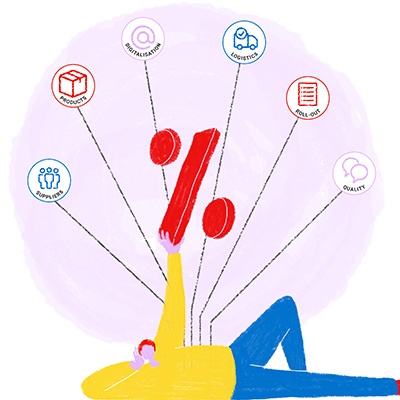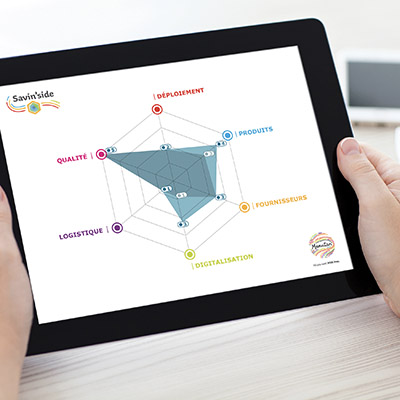Initially limited to a few sectors due to technical and/or technological reasons, pay-as-you-go billing is becoming more widespread. This new economic model is transforming many industries and offering unprecedented opportunities for companies, thanks to increased flexibility and efficiency. It’s no longer about selling a product or service, but rather billing customers based on their consumption. It’s now up to the procurement function to familiarise itself with this pricing model to gain performance and profitability.
What is pay-as-you-go billing?
These billing models, also known as "metered billing" or "consumption-based pricing", reveal new ways of conceiving a product or service, or estimating its value. This directly echoes the concept of the functionality economy, which consists of selling a performance of use (or a usage) rather than the possession of a good.
It is therefore a model built on the principle of service. Pay-as-you-go billing no longer values the object of a sale itself, but the benefits it brings. In other words, a customer pays for the use of a good or service. The billing system relies on the collection and analysis of usage data, which is ensured by technologies such as the Internet of Things (IoT).
Thanks to the latest technological advances, even the most tangible products can be billed on a pay-as-you-go basis. For example, there are lighting solutions where the customer doesn’t buy bulbs as products but pays for the light their company consumes.
This logic can be applied in all areas:
- One can bill for a number of photocopies;
- A quantity of kilometres travelled;
- A temperature level in buildings;
- Energy optimisation…
Today, an increasing number of goods are therefore billed on a pay-as-you-go basis within companies, which opens up new opportunities for the procurement function.
The benefits of pay-as-you-go billing
This billing model presents many advantages for companies, ranging from resource optimisation to contributing to CSR (Corporate Social Responsibility) strategy.
Mastering and optimising resources
Pay-as-you-go billing allows companies to adjust their purchases to their actual needs. Rather than investing in standardised solutions with high fixed costs that don’t fully meet their requirements, companies can choose customisable products and services adapted to their consumption. This increased flexibility allows for a more precise allocation of financial resources, which helps to avoid waste as well as optimise operational efficiency and costs.
Gaining economic performance
Thanks to sensors and data technologies, an increasing number of products can be billed on a pay-as-you-go basis. Thus, the procurement function more frequently has the possibility to transform capex (capital expenditure, i.e. elements "owned" by the company) into opex (operating expenses, i.e. the charges borne by a company to ensure its activity). This constitutes an economic advantage for the company, which lowers its fixed charges and investments.
Contributing to CSR strategy
Natacha Tréhan, professor in procurement management and a researcher at the University of Grenoble Alpes, explains: "this model enables us to be at the heart of an environmental, sustainable value, and circular economy logic. The gain here for the supplier is to make their machines last as long as possible, [to fight] against planned obsolescence, to offer value-added maintenance and energy savings services… with less energy-consuming machines."
For its part, the procurement function accesses indicators that allow it to support its CSR strategy. Thanks to pay-as-you-go billing, it can prioritise a sustainable procurement policy:
- By choosing sustainable value;
- Selecting less energy-consuming equipment;
- Reducing carbon footprint;
- Etc.
Pay-as-you-go billing: A new deal with its set of challenges
Pay-as-you-go billing is emerging as an innovative economic model that profoundly influences relationships between companies and suppliers. This changes traditional expectations and imposes new challenges and responsibilities on suppliers. This system also raises contractual, legal and data protection issues that require rigorous attention.
The issues and challenges of pay-as-you-go billing in supplier-customer relations
Pay-as-you-go billing changes a company’s expectations towards its suppliers. This model gives the supplier a stronger involvement in product supply. It requires them to provide more additional services, such as energy saving.
Consequently, the supplier potentially intervenes throughout the product’s life cycle. They hold greater responsibility in the perception of product or service quality by the customer, both before and after the purchase. However, the pay-as-you-go billing model still presents some obstacles that sometimes slow down its development in companies.
Contractual obstacles
The service logic inherent to the model requires the integration of new clauses, which demand, among other things, to provide for a service agreement by defining appropriate indicators.
Legal obstacles
Pay-as-you-go billing does not allow companies to benefit from financial advantages they relied on until now, as jurisdiction can change its category (asset/liability). For example, operational leasing is considered a capital expenditure, making it less advantageous from a tax perspective.
Data protection obstacles
As pay-as-you-go billed products rely on data management (held by the supplier), any stakeholder who doesn’t hold this data may fear a shift in the power balance. Faced with this, the procurement function must guarantee the protection of this data, especially as solutions exist: For example, with a contractual framework that clearly determines the possibilities of data exploitation between actors.
However, it would be a shame if these obstacles overshadowed the advantages of pay-as-you-go billing. This is why the procurement function must familiarise itself with this new model and master its contours to overcome these fears and exploit its full added value.
Driven by technological advances related to data, the pay-as-you-go billing model is gradually gaining all activity sectors. It’s actually one of the great predictions of the World Economic Forum: All products will be services by 2030. The procurement function must take full advantage to operate better cost management and strengthen the economic performance of its organisation, while reinforcing its sustainable procurement policy. By adopting this approach, companies will transform their way of managing procurement and position themselves for sustainable growth in a constantly evolving environment.









